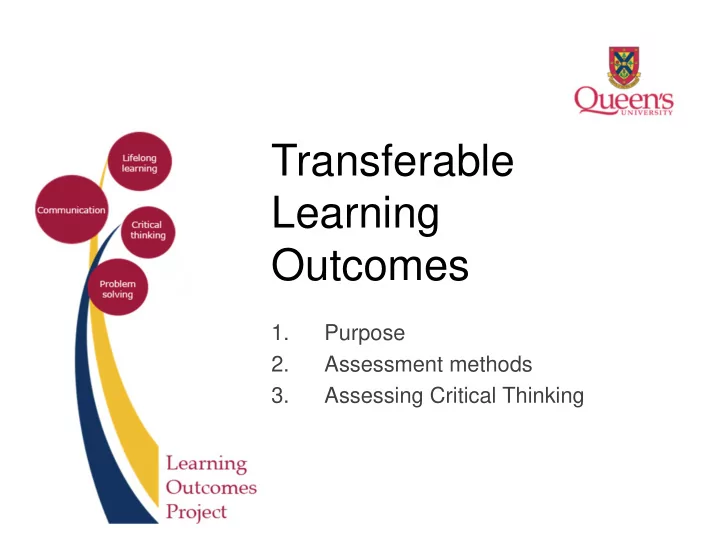

Transferable Learning Outcomes 1. Purpose 2. Assessment methods 3. Assessing Critical Thinking
AAC&U survey of 318 US employers: said demonstrated capacity to think critically, 93% communicate clearly, and solve complex problems is more important than knowing content
ASSESSMENT Longitudinal study of intellectual skills development undergraduate students Standardized Standardized Task work/ Task work/ Qualitative Qualitative Measurement Measurement evidence evidence Evaluation Evaluation 1. 1. CLA+ test CLA+ test 5. 5. VALUE VALUE 4. 4. Problem Problem 2. 2. CAT test CAT test rubrics rubrics solving solving 3. 3. MSLQ MSLQ activities activities
WORKING WITH FOUR DEPARTMENTS: DRAMA; ENGINEERING; PHYSICS; PSYCHOLOGY Sample for CLA+ and VALUE Rubric Marking 300 CLA+ Tested 250 VALUE Marked Sample 200 Frequency (n) 150 100 50 0 DRAM100 PSYC100 APSC100 PHYS104 DRAM400 PSYC501 MECH462 APSC480 GEOE447 CIVL471 PHYS460 1st Year 4th Year
CLA+ VALUE ADDED INSTITUTIONAL PROGRAM CLA+ total score boxplot for for 1 st year (n= 232) and 4th (year n= 50) engineering sample
VALUE RUBRICS 1 ST Year to 4 th Year Cross Sectional Mean Scores Psychology 100 and 501 Written Problem Solving Critical Thinking Communication 4 3.5 1st Year 3 (n=93) Rubric Levels 2.5 2 4th Year 1.5 (n=32) 1 0.5 0
Using the VALUE Rubrics (work with a partner; see Work sample and rubric handouts) 1. Become familiar with the rubrics and language 2. Understand the work sample 3. Look for evidence- dimension by dimension 4. Decide on the level based on the evidence. Discuss any rating differences and come to a common understanding (calibration)
STUDENT WORK SAMPLE
What level of EXPLANATION OF ISSUES Did the evidence in the sample suggest? A. Benchmark 1 B. Milestone 2 C. Milestone 3 D. Capstone 4
EXPLANATION OF ISSUES • Defines the problem, describes some key terms (e.g. null and alternate hypothesis) • Clarifies the circumstances under which the hypothesis will be proven Does not provide background on • alcohol consumptions or conformity, thus leaving aspects of the problem unexplored. • Further defines an issue; describes accountability for reliability
EXPLANATION OF ISSUES
What level of EVIDENCE Did the evidence in the sample suggest? A. Benchmark 1 B. Milestone 2 C. Milestone 3 D. Capstone 4
EVIDENCE Did the task prompt student’s to consider evidence? Was there any reference to sources? Ratings may be either not applicable (NA), or not demonstrated (ND) N o t d e m o n s t r a t e d
What level of CONTEXT AND ASSUMPTIONS Did the evidence in the sample suggest? A. Benchmark 1 B. Milestone 2 C. Milestone 3 D. Capstone 4
INFLUENCE OF CONTEXT AND ASSUMPTIONS • Begins to question the assumption that constructs are universally understood • Identifies multiple circumstantial, environmental and ethical factors that may complicate or influence the problem within the given context States an assumption of the • researcher relating to desired results
INFLUENCE OF CONTEXT AND ASSUMPTIONS N o t d e m o n s t r a t e d
What level of STUDENT’S POSITION Did the evidence in the sample suggest? A. Benchmark 1 B. Milestone 2 C. Milestone 3 D. Capstone 4
STUDENT’S POSITION • Accounts for one possible confound, but does not consider the confounds that may be remaining • Begins to acknowledges different sides of the issue but position remains simplistic
d e m o n s t r a t e d STUDENT’S POSITION N o t
What level of CONCLUSIONS AND RELATED OUTCOMES Did the evidence in the sample suggest? A. Benchmark 1 B. Milestone 2 C. Milestone 3 D. Capstone 4
CONCLUSIONS AND RELATED OUTCOMES • Demonstrates awareness of the ethical impacts of a study involving alcohol, but does not discuss the ramifications. • Conclusion is tied to information presented throughout; some related and relevant implications and outcomes are identified (e.g. reliability, publishing for scholarly community).
CONCLUSIONS AND RELATED OUTCOMES N o t d e m o n s t r a t e d
Lessons… • Resource implications • Tools • Time • Marking- consistency achieved through calibration • Logistical challenges • Differences between disciplines • Validity of sample and data matching
Recommend
More recommend